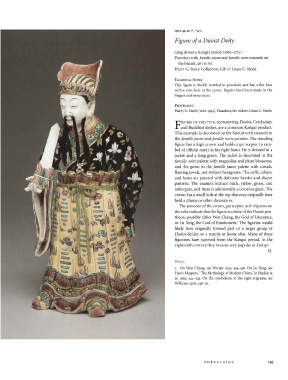Page 211 - Decorative Arts, Part II: Far Eastern Ceramics and Paintings, Persian and Indian Rugs and Carpets
P. 211
1972.43-40 (C-595)
Figure of a Daoist Deity
Qing dynasty, Kangxi period (1662-1722)
Porcelain with famille jaune and famille noire enamels on
the biscuit, 26 (ioV4)
Harry G. Steele Collection, Gift of Grace C. Steele
TECHNICAL NOTES
This figure is thickly molded in porcelain and has a flat base
with a vent-hole at the center. Repairs have been made in the
fingers and moustache.
PROVENANCE
Harry G. Steele [1881-1941], Pasadena; his widow, Grace C. Steele.
IGURES OF THIS TYPE, representing Daoist, Confucian,
F and Buddhist deities, are a common Kangxi product.
This example is decorated on the biscuit with enamels in
the famille jaune and famille noire palettes. The standing
figure has a high crown and holds a gui scepter (a sym-
bol of official rank) in his right hand. He is dressed in a
jacket and a long gown. The jacket is decorated in the
famille noire palette with magnolias and plum blossoms,
and the gown in the famille jaune palette with clouds,
flaming jewels, and stylized hexagrams. The cuffs, collars,
and hems are painted with elaborate border and diaper
patterns. The enamels include black, yellow, green, and
aubergine, and there is additionally a colorless glaze. The
crown has a small hole at the top that may originally have
held a plume or other decoration.
The presence of the crown, gui scepter, and trigrams on
the robe indicate that the figure is a deity of the Daoist pan-
theon, possibly either Wen Chang, the God of Literature,
1
or Lu Xing, the God of Emolument. The figurine would
likely have originally formed part of a larger group of
Daoist deities on a temple or home altar. Many of these
figurines have survived from the Kangxi period. In the
eighteenth century they became very popular in Europe.
SL
NOTES
i. On Wen Chang, see Werner 1932, 554-558. On Lu Xing, see
Henri Maspero, "The Mythology of Modern China," in Hackin et
al. 1963, 344-345. On the symbolism of the eight trigrams, see
Williams 1976,148-151.
P O R C E L A I N S 195

